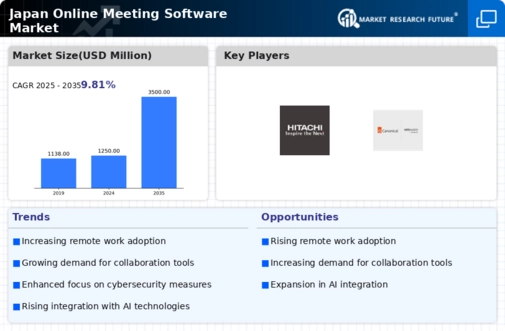The online meeting-software market in Japan is characterized by a dynamic competitive landscape, driven by rapid technological advancements and an increasing demand for remote collaboration tools. Major players such as Zoom Video Communications (US), Microsoft (US), and Cisco Systems (US) are at the forefront, each adopting distinct strategies to enhance their market presence. Zoom Video Communications (US) has focused on expanding its product offerings through continuous innovation, while Microsoft (US) leverages its existing ecosystem to integrate meeting software with its Office 365 suite, thereby enhancing user experience. Cisco Systems (US) emphasizes security and reliability, positioning its Webex platform as a trusted solution for enterprise clients. Collectively, these strategies contribute to a competitive environment that is increasingly centered around user-centric features and seamless integration with other digital tools.
In terms of business tactics, companies are increasingly localizing their services to cater to the unique needs of the Japanese market. This includes optimizing supply chains and enhancing customer support to improve user satisfaction. The market structure appears moderately fragmented, with several key players vying for dominance. However, the influence of major companies is substantial, as they set industry standards and drive innovation, thereby shaping the overall competitive dynamics.
In October 2025, Zoom Video Communications (US) announced the launch of a new AI-driven feature that enhances real-time language translation during meetings. This strategic move is likely to broaden its appeal in multilingual environments, positioning Zoom as a leader in accessibility and inclusivity. The introduction of such advanced features may not only attract new users but also retain existing customers who value innovative solutions that enhance communication.
In September 2025, Microsoft (US) unveiled a partnership with a leading Japanese telecommunications provider to enhance its Teams platform's connectivity and performance. This collaboration is strategically significant as it allows Microsoft to leverage local expertise and infrastructure, thereby improving service delivery and user experience in Japan. Such partnerships are indicative of a broader trend where global companies seek to localize their offerings to better meet regional demands.
In August 2025, Cisco Systems (US) launched a new initiative aimed at integrating its Webex platform with various third-party applications, enhancing interoperability. This strategic action reflects Cisco's commitment to creating a more versatile and user-friendly environment, which is essential in a market where flexibility and adaptability are increasingly valued. By fostering an ecosystem of integrated solutions, Cisco is likely to strengthen its competitive position.
As of November 2025, the competitive trends in the online meeting-software market are heavily influenced by digitalization, AI integration, and a growing emphasis on sustainability. Strategic alliances are becoming more prevalent, as companies recognize the value of collaboration in enhancing their service offerings. Looking ahead, competitive differentiation is expected to evolve, shifting from price-based competition to a focus on innovation, technological advancements, and supply chain reliability. This transition suggests that companies that prioritize these aspects will likely emerge as leaders in the market.













Leave a Comment